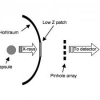Free Online Productivity Tools
i2Speak
i2Symbol
i2OCR
iTex2Img
iWeb2Print
iWeb2Shot
i2Type
iPdf2Split
iPdf2Merge
i2Bopomofo
i2Arabic
i2Style
i2Image
i2PDF
iLatex2Rtf
Sci2ools
VIS
2005
IEEE
2005
IEEE
Hardware-Accelerated Simulated Radiography
We present the application of hardware accelerated volume rendering algorithms to the simulation of radiographs as an aid to scientists designing experiments, validating simulation codes, and understanding experimental data. The techniques presented take advantage of 32-bit floating point texture capabilities to obtain solutions to the radiative transport equation for X-rays. The hardware accelerated solutions are accurate enough to enable scientists to explore the experimental design space with greater efficiency than the methods currently in use. An unsorted hexahedron projection algorithm is presented for curvilinear hexahedral meshes that produces simulated radiographs in the absorption-only regime. A sorted tetrahedral projection algorithm is presented that simulates radiographs of emissive materials. We apply the tetrahedral projection algorithm to the simulation of experimental diagnostics for inertial confinement fusion experiments on a laser at the University of Rochester. CR...
Hexahedron Projection Algorithm | Sorted Tetrahedral Projection | Tetrahedral Projection Algorithm | VIS 2005 | Visualization |
Related Content
| Added | 05 Nov 2009 |
| Updated | 05 Nov 2009 |
| Type | Conference |
| Year | 2005 |
| Where | VIS |
| Authors | Cláudio T. Silva, Daniel E. Laney, Nelson L. Max, Randall Frank, Steven Langer, Steven P. Callahan |
Comments (0)

